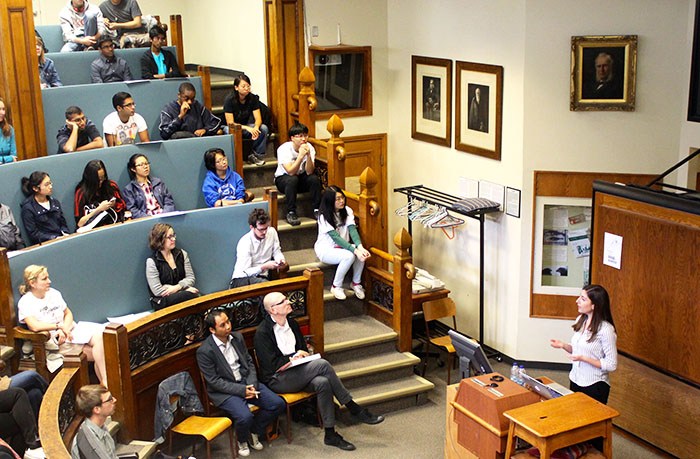Held at the beginning of every semester in Redpath Library, Soup and Science is an event unique to McGill during which professors from various science departments summarize their research in a series of three minute presentations. Coincidentally, the event also serves soup. The McGill Tribune sent writers to cover the Fall 2018 edition of Soup & Science, Sept 17-21. These are some of their favourite presentations.
Monday
Tina Giordano
Contributor
At the beginning of his presentation, Gil Bub associate professor in the Physiology department of Physiology posed a question to his audience: “Is the heart more like a forest fire or a spiral?”
Bub answered this query by granting audience members a glimpse into his research on the dynamics of excitable cell networks found in both the heart and the brain. In his talk, he compared a properly functioning heart to a forest fire, in which the fire starts, expands, and—after a period of recuperation—gives space for life to regrow. Similarly, the interconnected cells of a heart spread out, followed by a period of recovery before the next beat. Sometimes, however, the heart malfunctions and acts more like a cyclone, moving in a spiral; although these spirals presented via video were beautiful, they can be detrimental to one’s health.
In response, Bub’s lab is investigating how the use of optogenetics—using light signals to control and monitor cells—could control this spiralling activity. Luckily, a healthy heart is more like a forest fire. Bub’s research is helping to get to the heart of this complex phenomenon.
Tuesday
Morgan Sweeney
Contributor
Parasitic collections of genetic material that reproduce so violently they wreak havoc on the body are like something out of a science fiction movie. Luckily, Mike Strauss from the Anatomy and Cell Biology department is looking at the molecular mechanism of infection and trying to figure out how viruses work. More specifically, Strauss’ lab plans to analyze how viral RNA is able to pass through the cellular membrane.
To do this, Strauss and his team use an electron microscope to create a projection image, a two-dimensional recreation of the subject under study. To isolate the virus, they mark it with a fluorescent dye and then use a laser to cut a tiny area for the microscope to survey. After taking different samples, they can then reconstruct a three-dimensional image of the part of the cell containing the virus. High-tech precision is key when dealing with these little guys—the average virus measures 0.0000002 meters, so there isn’t a lot of room for error.
Thursday
Navneet Kaur
Contributor
Cynthia Chiang, associate professor in the Physics department, captivated her audience with a presentation on observational cosmology, or the study of the structure and evolution of the universe. Using state-of-the-art machinery in the form of a specialized telescope, Chiang’s research focuses on measuring redshifted 21-centimetre emissions of neutral hydrogen as well as the temperature and polarization of the cosmic background.
In discussing her explorations of the universe, Chiang revealed how she can tune a radio telescope to analyze the glow of hydrogen atoms and ‘listen’ to the history of the universe:
Using the fact that hydrogen atoms naturally glow at radio frequencies, researchers can hear the history by tuning radio telescopes to frequencies that match these hydrogen glow frequencies. Such an approach enables scientists to journey through the history of time in a matter of minutes.
Hearing a woman physicist explore daunting terrains and make ground-breaking discoveries while the sex ratio in the sciences remains concerning was an inspiration to many in the room.
Friday
Zoe Doran
Contributor
Yann le Polain de Waroux, assistant professor in the Geography department, discussed the expansion of agricultural frontiers in Gran Chaco, a region between Argentina, Paraguay, and Bolivia that experiences extreme rates of deforestation.
“[Agricultural frontiers can be] envisioned as places where agriculture is expanding over other uses,” le Polain de Waroux said.
Le Polain de Waroux’s research explores responses to deforestation in Gran Chaco by analyzing its biophysical characteristics, social actors, and the people’s relationship to the land. Using this data, he was able to explore how small communities living in these forests responded to large companies’ agricultural expansion.
The expansion of agriculture into the wilderness crucially strengthens the economy in the region but, when these frontiers begin to harm the biodiversity and carbon sequestration of the surrounding forests, environmental conflicts inevitably arise.
As le Polain de Waroux’s work emphasizes, much of the complexity of environmental issues, including deforestation and conservation, arises from the extremely subjective nature of sustainability: The most sustainable choice varies depending on the stakeholder. For the agricultural frontier in the Grand Chacho, the contrasting narratives of conservationists, agricultural corporations, and small communities illuminate the complexity of sustainable development.









